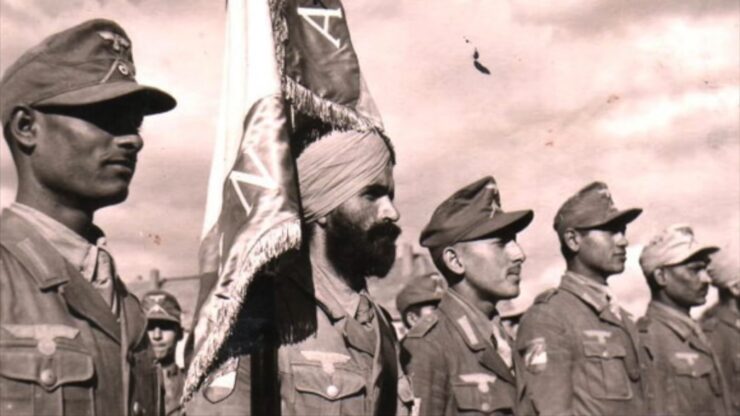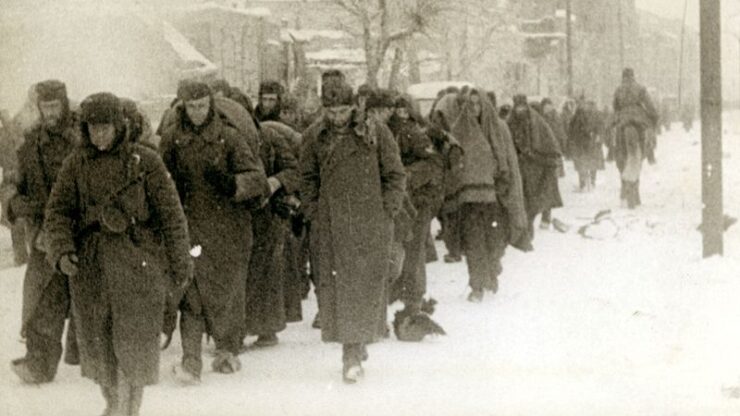World War Two stands as the most lethal conflict in human history, with an estimated 70 to 85 million casualties, encompassing both direct war impacts and indirect effects like disease and famine. The war’s impact varied significantly across nations.
For instance, the Soviet Union underwent profound changes, while life in the United States remained largely unchanged, barring a few exceptions.
Examining the casualties by nation provides insights into the diverse experiences during the war. To clarify, casualties refer to both injuries and deaths, while fatalities mean deaths alone.
10 Countries With The Highest World War II Fatalities
| Rank | Country/Former Country or Colony | Total No. of Fatalities |
|---|---|---|
| 1 | Soviet Union | 24,000,000 |
| 2 | China | 19,500,000 |
| 3 | Germany | 7,700,000 |
| 4 | Poland | 5,600,000 |
| 5 | Dutch East Indies (Indonesia) | 3,500,000 |
| 6 | Japan | 2,850,000 |
| 7 | India | 2,087,000 |
| 8 | French Indochina (Cambodia/Laos/Vietnam) | 1,250,000 |
| 9 | Yugoslavia | 1,000,000 |
| 10 | Romania | 833,000 |
| 11 | Greece | 825,000 |
| 12 | Philippines | 807,000 |
| 13 | Hungary | 580,000 |
| 14 | France | 567,600 |
| 15 | Italy | 457,000 |
| 16 | United Kingdom | 450,700 |
| 17 | Korea | 425,500 |
| 18 | United States | 418,500 |
| 19 | Austria | 384,700 |
| 20 | Lithuania | 353,000 |
10. Romania – 833,000

Initially choosing to remain neutral at the war’s onset, Romania’s political landscape shifted dramatically after a fascist coup in September 1940, aligning the country with the Axis powers.
Romanian troops subsequently joined the assault on the Soviet Union, engaging in battles across Ukraine, Moldova, and Stalingrad. Additionally, Romania’s involvement in the Holocaust was significant.
Under the leadership of Ion Antonescu, who held strong anti-Semitic views, numerous massacres, pogroms, and deportations took place, targeting Romanian, Ukrainian, and Moldovan Jews.
It’s believed that Antonescu’s directives led to the death of 100,000 to 400,000 Jews. In total, the war claimed the lives of around 833,000 Romanians.
9. Yugoslavia – 1,000,000
Germans leading residents of Kragujevac and nearby regions to their execution. On April 6, 1941, the Axis powers invaded the Kingdom of Yugoslavia, subsequently dividing it among Germany, Italy, Hungary, and Bulgaria. In response, Yugoslav communists formed the National Liberation Army, commonly referred to as the Yugoslav Partisans, initiating a guerilla warfare against the Axis-installed puppet government.
Initially, the royalist Chetniks allied first with Allies, but by 1943, they were betrayed by them. Despite such challenges, the resistance continued its fight, culminating in the country’s liberation in 1944. However, the victory was bittersweet, with approximately one million Yugoslavians losing their lives during the conflict.
8. French Indochina (Cambodia, Laos, And Vietnam) – 1,250,000
In 1939, the territories of Cambodia, Laos, and Vietnam were under French colonial rule, collectively known as French Indochina. But with France’s fall in 1940, the region was dominated by Vichy France, a puppet regime of the Nazis. Consequently, they granted significant privileges to Japan. By mid-1941, the Japanese Empire had complete control over French Indochina.
The period of occupation was marked by numerous brutalities, with the 1945 famine standing out, claiming the lives of at least 400,000 individuals. It’s crucial to note that the Japanese weren’t the only perpetrators; when the French forces reclaimed the colony in September 1945, there were widespread accounts of them looting, assaulting, and murdering Vietnamese civilians. The overall death toll in French Indochina during the war reached 1.25 million.
7. India – 2,087,000

Indian soldiers in North Africa, 6 October 1940. Indian soldiers in North Africa, 6 October 1940. In September 1939, India, then under British rule, declared war on Germany. Indian soldiers were deployed in various theaters of war, including Europe, North Africa, and Southeast Asia, leading to around 87,000 military casualties. Additionally, millions of civilians perished due to war-induced circumstances.
Notably, between 1940 and 1943, the Bengal region in Eastern India faced a severe famine, resulting in the deaths of millions. The reasons behind this catastrophe remain a topic of debate, but many historians concur that British colonial decisions, especially Winston Churchill’s decision to continue food exports from Bengal to Europe, significantly contributed. By the war’s conclusion, India’s death toll exceeded two million.
6. Japan – 2,850,000
Japan, although an instigator of the war, faced immense casualties. For example, between March 9 and March 10, 1945, U.S. planes unleashed incendiary bombs on Tokyo. Given the predominantly wooden architecture, the city was virtually reduced to ashes. Conservative figures estimate that around 80,000 Japanese civilians perished, while some believe the death toll surpassed 100,000.
The most infamous episode of mass casualties in Japan was the atomic bombings of Hiroshima and Nagasaki. To provide some background, as the U.S. forces advanced in 1945, it became evident that a direct invasion of Japan’s main islands would lead to enormous casualties.
Consequently, on August 6 and August 9, 1945, Hiroshima and Nagasaki were obliterated by atomic bombs, aiming to compel Japan to surrender. This tactic proved effective, as Japan capitulated shortly after. The bombings resulted in the deaths of between 129,000 to 226,000 individuals, predominantly civilians. Throughout the war, around four million Japanese, both military and civilian, were wounded, with an estimated two to three million fatalities.
5. Dutch East Indies (Indonesia) – 3,500,000
Colonies allied with the major powers weren’t spared from the devastating impacts of the war. Notably, after Japan’s occupation of China, they shifted their focus southward, launching an invasion on Indonesia, then referred to as the Dutch East Indies due to its colonial ties with the Netherlands, on December 8, 1941. This move was prompted by the earlier German invasion of the Netherlands.
The strategic importance of the Dutch East Indies, particularly its rubber plantations and oil reserves, made it a prime target to enhance Japan’s wartime capabilities. After a relentless four-month offensive, Japan successfully took control of the colony, leading to the Dutch forces’ surrender on March 9, 1942.
The subsequent three-year Japanese occupation was marked by widespread atrocities against the indigenous Indonesian population, including torture, forced prostitution, and outright killings. In total, the war resulted in a staggering 3.5 million deaths in the Dutch East Indies, with the majority being civilians
4. Poland – 5,600,000
In September 1939, Poland faced invasions from both Germany and the Soviet Union. While the initial invasions resulted in numerous Polish casualties, the subsequent joint occupation led to even more devastating losses. Notably, after the 1944 Warsaw Uprising spearheaded by the Polish resistance, the Nazis retaliated by killing at least 150,000 civilians.
Moreover, Poland was the location for many of the Holocaust’s infamous death camps, including Auschwitz, Treblinka, and Belzec. The Soviet Union, too, committed significant atrocities against the Polish people. A prime example is the Katyn Massacre that took place between April and May 1940, where approximately 22,000 Polish military officers were executed and buried in the Katyn Forest.
By the end of World War II, Poland had suffered a staggering loss of around 5.6 million lives, which equated to nearly 17% of its total population.
3. Germany – 7,700,000
Despite being the main aggressor in the European war, Germany still suffered an immense number of casualties. For instance, in July 1943, the Allies launched a strategic bombing campaign over the northern city of Hamburg, resulting in 37,000 civilians being killed and nearly 200,000 being injured. In February 1945, another bombing over Dresden led to at least 22,700 civilian deaths.
This attack was particularly controversial since Dresden had little strategic significance and contained few military targets. In total, between 350,000 to 500,000 Germans were killed by Allied aerial bombing. Furthermore, about 7.7 million Germans were killed throughout the entire war.
2. China – 19,500,000
The conflict began in 1931 when Japan invaded Manchuria, and escalated in 1937 following an incident at the Marco Polo Bridge, leading to Japan’s full-scale invasion of China. The war was marked by heinous war crimes, the most infamous being the Nanjing Massacre from December 1937 to January 1938, where Japanese forces killed an estimated 40,000 to 300,000 Chinese civilians.
Such brutalities were widespread, making it challenging for Japan to gain any Chinese allies. China’s ongoing civil war further weakened its nationalist government, rendering it largely ineffective against the Japanese. The deadlock was eventually broken by the US’s involvement in World War II and the efforts of communist guerillas led by Mao Zedong. The war resulted in the deaths of approximately 19.5 million Chinese.
1. Soviet Union – 24,000,000
The iconic image from July 12, 1942, captures a Soviet officer, believed to be Ukrainian Alexei Yeryomenko, leading his troops against the German invaders in Soviet Ukraine. The German onslaught, known as Operation Barbarossa, began on June 22, 1941, and was divided into three major offensives.
Army Group North targeted Leningrad, Army Group Center aimed for Moscow, and Army Group South advanced towards Ukraine and the Caucasus. Each of these offensives witnessed immense devastation.
The Siege of Leningrad, lasting from September 1941 to January 1944, led to the deaths of between 600,000 to a million people, primarily from starvation. The Battle of Moscow, from September 1941 to January 1942, saw the Red Army repelling the Germans, but at a significant human toll. The southern city of Stalingrad became a battleground from August 1942 to January 1943, resulting in over a million Soviet casualties.
The Nazi racial ideology placed Slavs and Jews at the bottom, making the invasion of the USSR a racial conflict. This marked the onset of the Holocaust for the Soviet Jews. Unlike their European counterparts, most Soviet Jews were executed by shooting in the initial months of the German occupation.
By December 1942, approximately 1.2 million Soviet Jews had been exterminated. In total, the war claimed around 24 million lives in the USSR, which was about 13.7% of its population.
Final Words
World War II remains a stark reminder of the devastating consequences of unchecked aggression and ideological extremism. The staggering number of casualties across nations underscores the global nature of the conflict and the profound impact it had on entire populations.
While some countries faced direct invasions and occupations, others grappled with the indirect effects of the war, such as famine and disease. As we reflect on these numbers, it’s essential to remember the individual lives behind each statistic and the collective trauma endured by entire nations. By understanding the past, we can hope to prevent such tragedies in the future.












